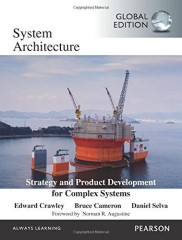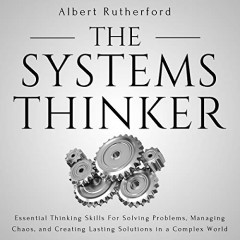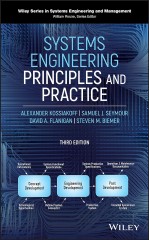In today’s rapidly evolving technological landscape, the challenges faced by systems engineers are becoming increasingly complex. From developing advanced aerospace systems to designing intricate software architectures, the demand for innovative solutions has never been higher. Enter design thinking – a methodology that, when integrated with systems engineering, has the potential to revolutionize how we approach and solve these multifaceted problems.
Systems engineering, at its core, is a methodical and interdisciplinary approach to designing, realizing, and managing complex systems over their entire lifecycle. It focuses on defining customer needs and required functionality early in the development cycle, documenting requirements, and then proceeding with design synthesis and system validation while considering the complete problem. This comprehensive approach has been the backbone of many successful large-scale projects across various industries.
On the other hand, design thinking is a human-centered approach to innovation that draws from the designer’s toolkit to integrate the needs of people, the possibilities of technology, and the requirements for business success. It emphasizes empathy, ideation, rapid prototyping, and user feedback. While traditionally associated with product design and user experience, design thinking has found applications in diverse fields, from business strategy to social innovation.
The synergy between systems engineering and design thinking lies in their complementary strengths. Where systems engineering excels in managing complexity and ensuring all parts of a system work together seamlessly, design thinking brings in a fresh perspective by focusing on the human element and encouraging creative problem-solving. By integrating these two approaches, we can create a powerful framework for tackling the most challenging problems in systems engineering.
In this blog post, we’ll explore how the principles of design thinking can be applied to enhance systems engineering processes. We’ll delve into practical applications, examine case studies, and discuss the potential challenges and benefits of this integrated approach. Whether you’re a seasoned systems engineer looking to innovate your methods or a design thinker curious about applying your skills to complex systems, this post aims to provide valuable insights into the future of problem-solving in the world of systems engineering.
Join us as we embark on this journey to unlock new possibilities at the intersection of systems engineering and design thinking.
Recommended Further Reading Amazon BooksTable of Contents
- 1. Understanding Design Thinking in the Context of Systems Engineering
- 2. The Design Thinking Process in Systems Engineering
- 3. Case Studies: Design Thinking in Action
- 4. Challenges and Benefits
- 5. Frequently Asked Questions: Design Thinking in Systems Engineering
- 6. Conclusion: Embracing Design Thinking in Systems Engineering
1. Understanding Design Thinking in the Context of Systems Engineering
Design thinking, when applied to systems engineering, offers a fresh perspective on problem-solving and innovation. To fully appreciate its potential impact, let’s delve deeper into what design thinking entails and how it complements the systems thinking approach that’s fundamental to systems engineering.
Definition of Design Thinking
Design thinking is an iterative, non-linear process that seeks to understand users, challenge assumptions, redefine problems, and create innovative solutions. It’s characterized by five key stages:
- Empathize: Understanding the needs of all stakeholders involved in the system.
- Define: Framing the right problem to solve based on stakeholder insights.
- Ideate: Generating a wide range of creative solutions.
- Prototype: Building representations of one or more ideas to test.
- Test: Trying out the solutions and gathering feedback for refinement.
In the context of systems engineering, these stages can be applied to various phases of the system lifecycle, from conceptualization to implementation and beyond.
Key Principles of Design Thinking
Several core principles of design thinking make it particularly valuable for systems engineering:
- Human-Centricity: Focusing on the needs and experiences of all system users and stakeholders.
- Collaboration: Encouraging cross-functional teamwork to leverage diverse expertise.
- Ideation: Generating numerous ideas before converging on solutions.
- Experimentation: Embracing a “fail fast, learn quick” mentality through rapid prototyping and testing.
- Iteration: Continuously refining solutions based on feedback and new insights.
These principles can help systems engineers approach complex problems with a more open and creative mindset, leading to more innovative and user-friendly solutions.
How Design Thinking Complements Systems Thinking
Systems thinking, a cornerstone of systems engineering, focuses on understanding how parts of a system interrelate and how systems work over time and within larger systems. Design thinking complements this approach in several ways:
- User Focus: While systems thinking considers all components of a system, design thinking ensures that human needs and experiences remain at the forefront.
- Problem Framing: Design thinking’s emphasis on problem definition can help systems engineers ensure they’re addressing the right issues within complex systems.
- Ideation and Innovation: The creative processes in design thinking can lead to novel solutions that might not emerge from traditional systems engineering approaches alone.
- Rapid Prototyping: Design thinking’s emphasis on quick, iterative prototyping can accelerate the testing and refinement of system components.
- Stakeholder Engagement: The collaborative nature of design thinking can improve communication with stakeholders throughout the system development process.
- Adaptability: Design thinking’s iterative approach aligns well with the need for adaptability in complex, evolving systems.
By integrating design thinking principles into systems engineering processes, we can create a more holistic approach that balances technical rigor with human-centered innovation. This integration can lead to systems that are not only technically sound but also more intuitive, user-friendly, and aligned with stakeholder needs.
Recommended Further Reading Amazon Books2. The Design Thinking Process in Systems Engineering
Integrating the design thinking process into systems engineering can lead to more innovative, user-centered solutions. Let’s explore how each stage of the design thinking process applies to systems engineering projects.
2.1 Empathize
In systems engineering, the empathize stage involves deeply understanding the needs, challenges, and perspectives of all stakeholders involved in the system.
In this stage, systems engineers focus on understanding the needs of all stakeholders involved in the system.
Systems engineers use various techniques to gain deep insights into the requirements, challenges, and expectations of users, operators, and other stakeholders. This ensures that the system design addresses real-world needs.
For large-scale systems, engineers employ a mix of qualitative and quantitative methods to gather comprehensive user insights across a broad user base.
| Technique | Description | Application in Systems Engineering |
|---|---|---|
| Interviews | In-depth conversations with stakeholders | Gather detailed insights from end-users, operators, and maintainers |
| Ethnographic Research | Observing users in their natural environment | Understand how users interact with existing systems |
| Empathy Maps | Visual tool to articulate what we know about user types | Capture insights about different user groups within the system |
| Surveys | Structured questionnaires for large-scale data collection | Collect quantitative data across a broad user base |
| Workshops | Collaborative sessions with diverse stakeholders | Engage multiple perspectives in understanding system requirements |
2.2 Define
The define stage in systems engineering involves framing the problem in a way that encompasses both technical requirements and user needs.
Engineers use design thinking tools to articulate problems in ways that encourage innovative solutions while still addressing technical constraints.
The goal is to translate user needs into specific, measurable system requirements, ensuring that the final system meets both technical specifications and user expectations.
| Method | Description | Systems Engineering Application |
|---|---|---|
| Problem Statements | Concise descriptions of the issue to be solved | Balance technical constraints with user-centered goals |
| “How Might We” Questions | Reframing challenges as opportunities | Encourage innovative thinking in system design |
| Affinity Diagrams | Organizing and synthesizing insights | Categorize and prioritize user needs and system requirements |
| Requirements Traceability Matrix | Linking user needs to system functions | Ensure all user needs are addressed in system design |
| Use Cases / User Stories | Narratives describing system usage | Capture both functional and non-functional requirements |
2.3 Ideate
In systems engineering, the ideate stage encourages creative thinking to generate a wide range of potential solutions.
Engineers use various techniques to think beyond conventional solutions, bringing together diverse perspectives to spark innovation.
Specific brainstorming methods are employed to tackle the unique challenges of complex systems, encouraging both breadth and depth in idea generation.
| Technique | Description | Systems Engineering Application |
|---|---|---|
| Cross-functional Brainstorming | Generating ideas with diverse teams | Combine perspectives from engineers, designers, and users |
| TRIZ | Theory of Inventive Problem Solving | Apply systematic approach to technical innovation |
| Mind Mapping | Visual diagram to explore ideas | Map interconnections between system components and solutions |
| 6-3-5 Brainwriting | Rapid idea generation in groups | Generate numerous ideas for complex system challenges |
| Analogical Thinking | Drawing inspiration from other domains | Find innovative solutions by looking at similar problems in different fields |
2.4 Prototype
Prototyping in systems engineering involves creating representations of the system or its components to test ideas and gather feedback.
Engineers use a variety of prototyping methods, from low-fidelity mockups to sophisticated simulations, to quickly test and iterate on ideas.
The challenge is to create prototypes that are detailed enough to provide meaningful insights, yet quick and inexpensive enough to allow for rapid iteration.
| Prototype Type | Description | Appropriate Use in Systems Engineering |
|---|---|---|
| Low-fidelity (Lo-fi) | Simple, quick to create (e.g., sketches, wireframes) | Early concept testing, rapid iteration of ideas |
| High-fidelity (Hi-fi) | Detailed, close to final product | Testing specific functionalities, user interfaces |
| Physical Prototypes | 3D prints, mock-ups | Testing ergonomics, physical interfaces |
| Digital Twins | Virtual replicas of physical systems | Simulating complex behaviors, testing control algorithms |
| Simulations | Computer models of system behavior | Testing system dynamics, performance under various conditions |
2.5 Test
The test stage in systems engineering involves evaluating prototypes and gathering feedback to refine the system design.
Testing incorporates both traditional systems engineering validation methods and user-centric evaluation techniques from design thinking.
For complex systems, testing is often done in phases, allowing for incremental improvements and adaptation to changing requirements or insights.
| Testing Method | Description | Systems Engineering Application |
|---|---|---|
| Usability Testing | Evaluating ease of use | Assess user interfaces and system interactions |
| Functional Testing | Verifying system functions | Ensure system meets specified requirements |
| A/B Testing | Comparing alternative designs | Evaluate different solutions for software components |
| Pilot Studies | Small-scale preliminary studies | Gather real-world feedback on system performance |
| Continuous Integration/Deployment | Automated testing and deployment | Rapidly test and iterate software components |
By systematically applying these design thinking stages and techniques to systems engineering projects, teams can create more innovative, user-centered solutions while maintaining the rigorous technical standards required in complex systems development.
Recommended Future Learn Short Courses3. Case Studies: Design Thinking in Action
To better understand how design thinking can be applied in systems engineering, let’s explore three real-world examples from different industries. These case studies demonstrate the practical benefits of integrating design thinking principles into complex systems development.

3.1 Aerospace Industry Example: Redesigning the Cockpit Experience
Background:
A major aircraft manufacturer sought to improve the cockpit design for their next-generation commercial airliner, aiming to enhance pilot experience and operational efficiency.
Application of Design Thinking:
- Empathize: Conducted extensive interviews and observational studies with pilots, co-pilots, and flight engineers across various airlines.
- Define: Identified key issues such as information overload, fatigue during long flights, and the need for better ergonomics.
- Ideate: Held workshops combining aerospace engineers, UX designers, and experienced pilots to generate innovative solutions.
- Prototype: Developed a high-fidelity cockpit simulator incorporating new interface designs and ergonomic features.
- Test: Conducted rigorous testing sessions with pilots, iterating based on feedback and performance metrics.
Outcome:
The resulting cockpit design featured an intuitive glass cockpit interface, improved seat ergonomics, and an AI-assisted flight management system. This led to a 20% reduction in pilot fatigue on long-haul flights and a 15% improvement in response times during critical scenarios.

3.2 Defense Systems Example: Enhancing Soldier Communication Systems
Background:
A defense contractor was tasked with developing a new battlefield communication system that would improve coordination and information sharing among infantry units.
Application of Design Thinking:
- Empathize: Embedded designers with infantry units during training exercises to understand the challenges of battlefield communication.
- Define: Identified key issues including equipment weight, battery life, and the need for non-verbal communication options.
- Ideate: Conducted brainstorming sessions with combat veterans, communication engineers, and UX specialists.
- Prototype: Developed multiple prototypes, including a lightweight headset with bone conduction technology and a wearable tactile communication device.
- Test: Performed field tests under various simulated combat scenarios, gathering quantitative data and qualitative feedback.
Outcome:
The final system incorporated a lightweight, bone-conduction headset with integrated AR display, and a wrist-worn tactile communicator. This new system reduced communication errors by 40% and increased squad coordination effectiveness by 35% in field tests.

3.3 Transportation Systems Example: Reimagining Urban Public Transit
Background:
A large city aimed to overhaul its public transportation system to increase ridership, improve accessibility, and reduce carbon emissions.
Application of Design Thinking:
- Empathize: Conducted city-wide surveys, focus groups, and “ride-along” observations with diverse groups of commuters.
- Define: Identified key challenges including last-mile connectivity, real-time information accessibility, and the need for a more integrated multi-modal system.
- Ideate: Organized a series of public workshops and an open innovation challenge to gather ideas from citizens, urban planners, and technology experts.
- Prototype: Developed a digital twin of the city’s transportation system to simulate various solutions, and piloted a new multi-modal trip planning app.
- Test: Implemented changes in phases, starting with a pilot program in one district before city-wide rollout.
Outcome:
The redesigned system featured a unified payment system across all modes of transport, AI-optimized bus routes, and a user-friendly app for real-time multi-modal trip planning. This resulted in a 25% increase in public transport ridership and a 30% reduction in average commute times.
These case studies demonstrate how the integration of design thinking into systems engineering can lead to innovative solutions that not only meet technical requirements but also significantly improve user experience and system effectiveness. By putting human needs at the center of the design process, even highly complex systems can be made more intuitive, efficient, and impactful.
4. Challenges and Benefits
The integration of design thinking into systems engineering processes offers significant advantages but also presents unique challenges. Understanding both can help organizations effectively implement this approach and maximize its benefits.
4.1 Challenges
| Challenge | Description | Potential Mitigation Strategies |
|---|---|---|
| Cultural Resistance | Traditional engineering cultures may resist the more open-ended, iterative approach of design thinking. | – Provide training and workshops on design thinking – Showcase successful case studies – Encourage cross-functional teams |
| Time Constraints | Design thinking’s iterative nature may seem at odds with tight project timelines. | – Integrate design thinking activities into existing project phases – Use rapid prototyping techniques – Focus on critical user touchpoints |
| Scalability | Applying design thinking principles to large-scale, complex systems can be daunting. | – Use modular approaches, applying design thinking to subsystems – Leverage digital tools for remote collaboration and idea sharing – Develop a scalable framework tailored to the organization |
| Balancing User Needs with Technical Requirements | Reconciling user desires with technical constraints and regulatory requirements can be challenging. | – Develop clear prioritization frameworks – Involve technical experts in ideation sessions – Use QFD (Quality Function Deployment) to align user needs with technical specifications |
| Measuring Impact | Quantifying the ROI of design thinking in systems engineering can be difficult. | – Establish clear metrics at the outset of projects – Use both quantitative (e.g., performance improvements) and qualitative (e.g., user satisfaction) measures – Conduct longitudinal studies to track long-term impact |
4.2 Benefits
| Benefit | Description | Example |
|---|---|---|
| Enhanced User Satisfaction | By focusing on user needs from the outset, systems are more likely to meet or exceed user expectations. | A military communication system designed with soldier input led to a 40% increase in user satisfaction ratings. |
| Increased Innovation | The ideation and prototyping stages of design thinking can lead to breakthrough solutions. | An aerospace company used design thinking to reimagine aircraft maintenance, resulting in a predictive system that reduced downtime by 25%. |
| Reduced Rework and Costs | Early user testing and iterative development can identify and solve issues before they become costly to change. | A transportation system redesign caught and resolved user interface issues early, saving an estimated $2 million in potential rework. |
| Improved Cross-functional Collaboration | Design thinking encourages diverse teams to work together, breaking down silos. | A defense contractor reported a 30% increase in cross-department collaboration after implementing design thinking practices. |
| Better Alignment with Stakeholder Needs | The empathy stage ensures that all stakeholder perspectives are considered in the system design. | A smart city project using design thinking principles saw a 50% increase in public approval ratings compared to previous initiatives. |
| Faster Time-to-Market | Despite the iterative nature, design thinking can actually speed up development by ensuring the right product is built from the start. | A medical device company reduced their product development cycle by 4 months after integrating design thinking with their systems engineering process. |
| Enhanced System Adaptability | The iterative nature of design thinking creates systems that are more flexible and adaptable to changing needs. | An AI-driven traffic management system designed with design thinking principles was able to adapt 60% faster to unexpected traffic patterns. |
By understanding and addressing these challenges while leveraging the benefits, organizations can successfully integrate design thinking into their systems engineering processes. This integration can lead to more innovative, user-centered systems that not only meet technical requirements but also provide enhanced value to all stakeholders.
5. Frequently Asked Questions: Design Thinking in Systems Engineering
Q: What is design thinking, and how does it differ from traditional systems engineering approaches?
A: Design thinking is a human-centered approach to innovation that draws from the designer’s toolkit to integrate the needs of people, the possibilities of technology, and the requirements for business success. It differs from traditional systems engineering by emphasizing empathy, rapid prototyping, and iterative testing. While systems engineering focuses on technical requirements and system integration, design thinking adds a layer of user-centric innovation.
Q: How can design thinking be integrated into the systems engineering process?
A: Design thinking can be integrated at various stages of the systems engineering process:
- Requirements gathering: Use empathy techniques to understand stakeholder needs
- Concept development: Apply ideation methods to generate innovative solutions
- Design: Utilize rapid prototyping to test ideas quickly
- Testing: Incorporate user feedback early and often in the development process
- Implementation: Use iterative approaches to refine the system based on user interaction
Q: What are the main benefits of incorporating design thinking into systems engineering?
A: Key benefits include:
- Enhanced user satisfaction
- Increased innovation in problem-solving
- Reduced rework and associated costs
- Improved cross-functional collaboration
- Better alignment with stakeholder needs
- Faster time-to-market
- Enhanced system adaptability
Q: Are there any challenges in implementing design thinking in systems engineering?
A: Yes, some challenges include:
- Cultural resistance in traditional engineering environments
- Balancing time constraints with the iterative nature of design thinking
- Scaling design thinking practices for large, complex systems
- Reconciling user desires with technical and regulatory requirements
- Measuring the impact and ROI of design thinking initiatives
Q: How can I start incorporating design thinking into my systems engineering projects?
A: You can start by:
- Introducing empathy mapping or user journey mapping in your requirements gathering phase
- Conducting ideation workshops during concept development
- Implementing rapid prototyping techniques for early testing
- Increasing user involvement throughout the development process
- Training your team in design thinking methodologies
Q: Does design thinking replace systems engineering methodologies?
A: No, design thinking complements rather than replaces systems engineering. It adds a human-centered, creative problem-solving approach to the rigorous technical processes of systems engineering.
Q: How does design thinking affect project timelines in systems engineering?
A: While design thinking introduces more iterative processes, it can actually reduce overall project time by:
- Identifying and solving issues earlier in the development cycle
- Ensuring the right solution is developed from the start, reducing rework
- Improving stakeholder communication and alignment, minimizing delays due to misunderstandings
Q: Are there specific tools or software that support the integration of design thinking and systems engineering?
A: Yes, several tools can help:
- Collaboration platforms like Miro or MURAL for virtual ideation and empathy mapping
- Prototyping tools like Sketch or Adobe XD for user interface design
- Project management tools like Jira or Trello that support agile, iterative processes
- Simulation software that allows for rapid testing of system concepts
Q: How does design thinking handle the complexity inherent in many systems engineering projects?
A: Design thinking addresses complexity by:
- Breaking down large problems into smaller, manageable chunks
- Using visual tools like journey maps and service blueprints to illustrate complex systems
- Encouraging cross-functional collaboration to tackle multifaceted challenges
- Employing iterative prototyping to test and refine complex solutions incrementally
Q: Can design thinking be applied to all types of systems engineering projects?
A: While design thinking can be beneficial in most systems engineering projects, it’s particularly valuable in projects that:
- Have a significant user interface or user experience component
- Require innovative solutions to complex problems
- Involve multiple stakeholders with diverse needs
- Need to adapt to changing requirements or environments
Remember, the key to successfully integrating design thinking into systems engineering is to remain flexible and adapt the approach to your specific project needs and organizational culture.
6. Conclusion: Embracing Design Thinking in Systems Engineering
As we’ve explored throughout this post, the integration of design thinking into systems engineering offers a powerful approach to tackling complex challenges in our increasingly interconnected world. By combining the rigorous, analytical methods of systems engineering with the human-centered, creative processes of design thinking, we can develop solutions that are not only technically sound but also intuitive, user-friendly, and truly impactful.
Let’s recap the key takeaways:
- Design thinking complements systems thinking by putting human needs at the forefront of the development process.
- The five stages of design thinking – Empathize, Define, Ideate, Prototype, and Test – can be effectively applied to various phases of systems engineering projects.
- Real-world case studies from aerospace, defense, and urban planning demonstrate the tangible benefits of this integrated approach.
- While challenges exist in implementing design thinking in systems engineering, the benefits – including enhanced user satisfaction, increased innovation, and improved collaboration – far outweigh the difficulties.
- Tools and techniques from both disciplines can be combined to create a more holistic approach to problem-solving.
As systems engineers, we are tasked with creating solutions to some of the most complex challenges of our time. By embracing design thinking, we have the opportunity to elevate our practice, creating systems that not only function flawlessly but also resonate deeply with the people they serve.
Call to Action
- Experiment: Start small by incorporating design thinking techniques into your next project. Try running an empathy mapping session or a rapid prototyping workshop.
- Educate: Share this approach with your team. Consider organizing a lunch-and-learn session to discuss how design thinking could benefit your specific projects.
- Collaborate: Reach out to designers or UX professionals in your organization. Their insights could prove invaluable in your next systems engineering challenge.
- Iterate: Remember, adopting design thinking is itself an iterative process. Be patient, learn from each attempt, and continuously refine your approach.
By taking these steps, we can push the boundaries of what’s possible in systems engineering, creating solutions that are more innovative, more human-centered, and ultimately more successful.
























